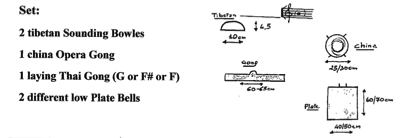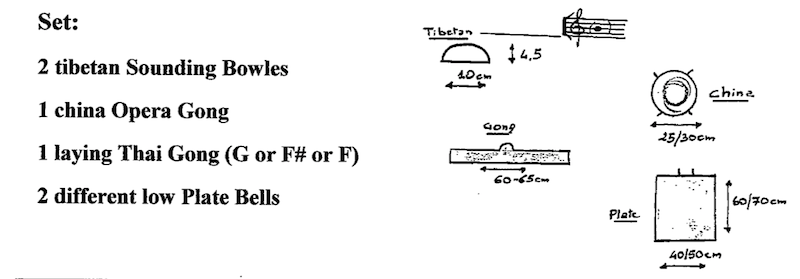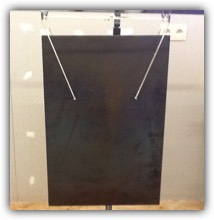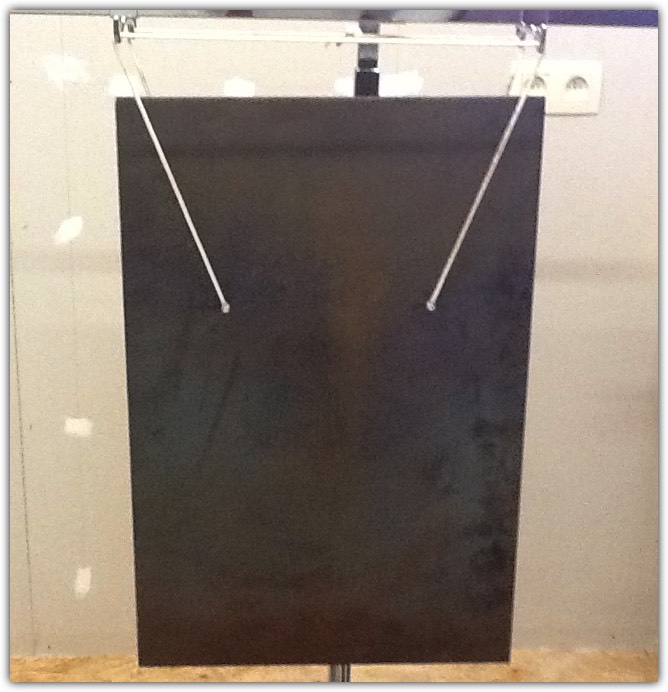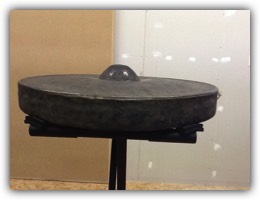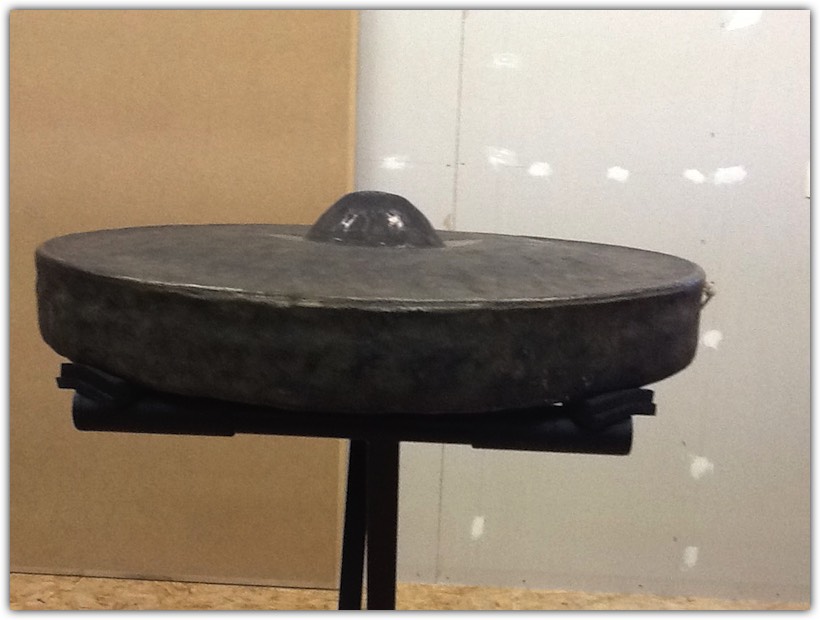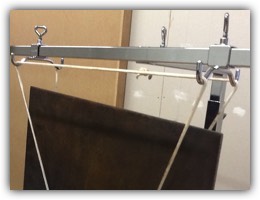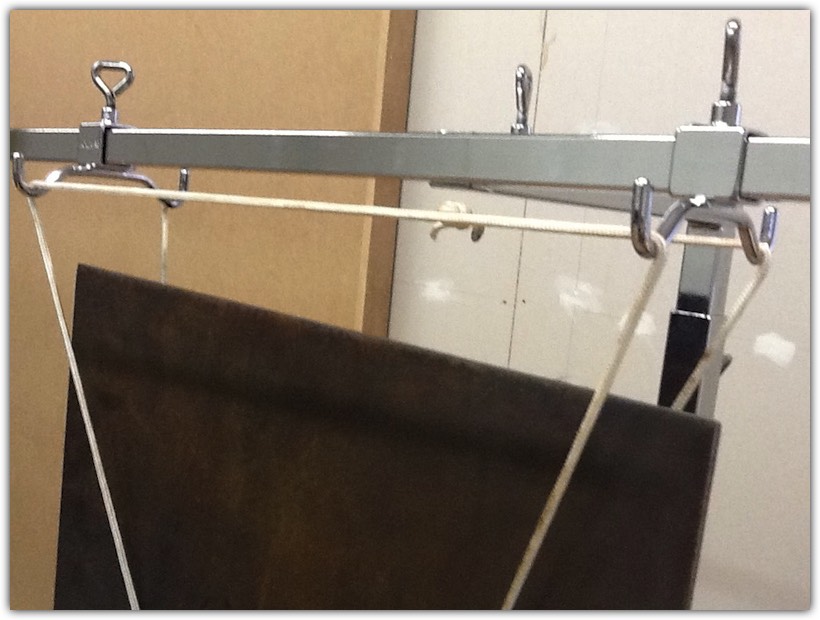Improving the practice and performance of contemporary music
Practical difficulties
Finding the instruments
Billone writes for 2 Tibetan sounding bowls of about 10 cm diameter, a China opera gong of 25 to 30 cm diameter, “laying” Thai gong (G, F or F#) and two different low bell plates with measurements of 40cm x 60cm up to 50cm x 70cm.
The Tibetan sounding bells, China opera gong and Thai gong can be purchased easily at Asian sound Köln or at Kolberg Percussion (although the latter will be probably more expensive for all of these instruments). Plate bells can also be purchased at Kolberg Percussion or UFIP, but these plate bells are constructed in brass, an alloy with amazing acoustic characteristics but also a very high price. I constructed mine myself at a local steel handler.
Billone asks for two Tibetan sounding bowls of about 10 cm diameter with a pitch around the note B4. I started using the normal chromatic tuned series Asian sound has standard in stock. This series, however, is usually not the thickest sounding bowls and tends to break or tear due to the heavy hitting and dragging in the piece. This exact problem happened to me when I was recording the piece in the studio and I didn’t have any spare bowls with me. Luckily we had already done a full take of the piece just before the bowl broke. It is better to find two bowls of the non-tuned series that have a thicker edge. These bowls will be higher in pitch because of the mass of the metal. If you take a B4 in a thicker series of bowls, you won’t be able to hold the bowls anymore because the diameter will be significantly larger. Make sure you don’t order the instruments without hearing or seeing them. Go directly to your dealer to pick them.
The China opera gong can be larger than the 30 cm that is asked for. The larger the instrument, the more resonant it will be and thus the more sound possibilities you will have. Try a few different sizes and see which one matches you. Also bear in mind the weight of the instrument because, after all, you will have to carry it for half an hour in an intense playing situation.
For the laying Thai gong it is best to take a gong that is “non-tuned.” Of course all Thai gongs have a pitch, but some of those gongs are sold as non-tuned because they have a pitch that is quite unclear or ambiguous or they have too many overtones. I recommend this type of gong because they are cheaper and because the techniques Billone asks for in the piece tend to damage the instrument. Especially the dragging of the Tibetan sounding bowls and the loud hits on the bell are not very good for the instrument.
For the same reason, I did not want to use the brass bell plates by Kolberg or UFIP. They cost about 1000 € or more per piece if you want the size Billone asks for. I went to the local steel handler and asked him to cut two plates: one of 40cm x 60cm and the other of 45cm x 65cm. The difference in size between the two plates does not really matter; they just have to be different from each other. Both plates are 6 mm thick. Then I asked for two holes to be drilled in every plate at 1/3 of the length and 1/4 of the width of the plate. The plates are not as rich in overtones as the brass plates, but they sound a lot better than the aluminium type of bell plates and cost a fraction of the messing type (I paid 29 € for both plates). Additionally, the scratching with the sounding bowls damages the surface of the plate bells, somethin you don’t want to do with 1000 € Kolberg plates.
Mounting the instruments
The China opera gong comes standard with two holes drilled into the instrument or occasionally none at all. It will be necessary to drill two more at the opposite side of the existing holes with a cobalt drill head to mount it properly. The gong is mounted with a normal marimba cord or similar cord; one side goes around the neck and the other side around the waste, mounting the gong on the chest/abdomen. By bending over slightly, the gong will hang “freely” and can be played as if it were normally mounted on a stand. Experiment with the position until you find a way to carry it so it sounds natural. You will need both the dampened and the free sounding playing position to execute all the details in the score.
To mount the Thai gong, Billone asks to suspend it on wooden blocks on top of a resonance box, comparable to the system used in Mani. De Leonardis. However, I discovered that you could bring out the fundamental note of the gong much more by mounting the gong on a keyboard stand (or X-stand) with the foam I used for the spring coils in Mani. De Leonardis between the gong and the four points where the gong meets the stand. In this way, the gong is ”floating” instead of lying and can resonate almost freely.
I used very sturdy heavy-duty nylon rope to mount the bell plates to the stands. The drilling of the wholes sometimes leaves some edges that are quite sharp, so be careful the plates don’t fall down because the rope isn’t strong enough. Always make sure that the only point the rope touches the bell plate is where it passes through the hole. Like this, maximal resonance is assured. Kolberg has very good double hooks for this purpose. You can also mount a piece of wood between the two ropes so they don’t touch. The stands you use should also be very sturdy due to the weight of the plates. Possibilities are the Kolberg T-stands (quite expensive) or you can ask your local welder to build a construction that holds the two plates. The measurements of the metal bars of the stands are quite universal, so the Kolberg hooks should fit if you take the right bars.
